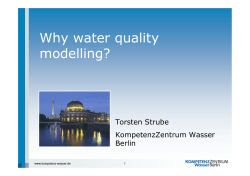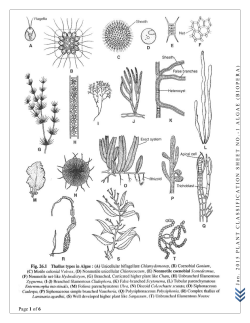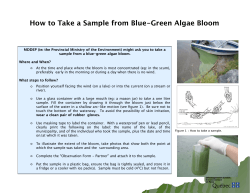
Document 273554
334 NOTES AN1 D COMMENT tures, there was no loss of orthophosphate after 24 hr of refrigeration, but freezing caused the release of 0.02 mg P per 40 fronds (less than 5 mg dry weight). The luxury-consumed phosphorous of algae is apparently released as orthophosphate with any of the methods used to kill the algae. This indicates that this phosphorus must be in highly labile forms that readily revert to orthophosphate when the algae die. The data indicate that significant quantities of orthophosphate and probably three to four times as much total phosphorus (Fitzgerald and Nelson 1966) will be released from algae if they are killed in water samples preserved for future analyses. Both freezing and the addition of chloroform appear to kill the algae and aquatic weed tested. The quantity of phosphorus released from algae in water samples will be dependent on the degree of killing (20% of Chlorella cells survived freezing at -15C Fitzgerald 1964b ) and the amount of surplus or stored phosphorus in the cell (Fitzgerald and Nelson 1966). In the fertile areas of the midwestern United States, algal blooms frequently amount to 10 mg dry weight/liter or more and the subsequent release of 0.02 to 0.06 mg of orthophosphate per liter may be a significant source of error for water analyses. Therefore, water samples to be preserved for future analyses by methods other SKILL IN THE USE OF than refrigeration should be filtered move any algae before preserving. G. P. FITZGERALD S. L. FAUST Water Chemistry Laboratory, Unitiersit y of Wisconsin, Madison, Wisconsin 53706. REFERENCES ALLEN, M. B. 1952. The cultivation of Myxophyceae. Arch. Mikrobiol., 17: 34-53. AMERICAN PUBLIC HEALTH ASSOCIATION. 1960. Standard methods for the examination of water and wastewater, 11th ed. APHA, New York, N.Y. 626 p. FITZGFCMLD, G. P. 1964a. Factors in the testing and application of algicides. Appl. Microbial., -. 12: 247-253. 1964b. The effect of algae on BOD measurements. J. Water Pollution Control Federation, 36: 1524-1542. -, AND S. L. FAUST. 1963. Bioassay for algicidal versus algistatic chemicals. Water Sewage Works, 110: 296-298. -, AND T. C. NELSON. 1966. Extractive and enzymatic analyses for limiting or surplus phosphorus in algae. J. Phycol., 2: 32-37. HUGHES, E. O., P. R. GORJXAM, AND A. ZEHNDER. 1958. Toxicity of a unialgal culture of Microcystzk aeruginosa. Can. J. ?rIicrobiol., 4: 225-236. RAINWATER, F. H., AND L. L. THATCHER. 1960. Methods for collection and analysis of water samples. U.S. Govt. Printing Office, Washington, D.C. 30 p, STRICKLAND, J. D. H., AND T. R. PARSONS. 1960. A manual of sea water analysis, p. 9 and 42. Bull. Fisheries Res. Board Can. 125. FOLSOM'S PLANKTON We have found that the Folsom plankton splitter sometimes gives poor replication when it is used to remove small aliquots from plankton samples by repeated halving of the sample; this has been particularly noticeable when aliquoting has been carried to the %2 or ?& level. The statistical analysis of the operation of Folsom’s splitter ( McEwen, Johnson, and Folsom 1954) had l This investigation was part of the Scripps Tuna Oceanography Research Program and was supported by U.S. Bureau of Commercial Fisheries Contract No. 14-17-0007-458. to re- SAMPLE SPLITTERI led us to believe that the splitter was more satisfactory than a Stempel pipette for extracting a subsample. It is obvious that splitting is uneven when the plankton forms clumps, as it usually does when a relatively small amount of plankton is suspended in a relatively large volume of preservative. The statistical tests referred to above, however, appear to have been carried out on samples in which the concentration of plankton organisms in the preserving fluid was relatively high. Both high and low concentrations are encountered when dealing with survey samples from NOTES TABLE 1. variation AND Standard deviations SD, coefficients of C and mean value of x2 for six replicate tests as described in the text Tests Deviations After standard mixing c Using operator judgment C Using air-mixing device SD X2 SD x2 SD C X’ Calanus Euphausia Sagitta 8.09 24.67 1.89 5.96 94.15 5.04 1.47 30.43 0.41 5.56 15.96 1.32 1.95 28.52 0.61 3.15 52.27 0.47 3.87 11.61 0.58 0.44 7.31 0.15 2.21 24.09 0.38 areas with different standing stocks, even though collected in a standard manner. Experience has shown that a careful technician, when taking aliquots with this apparatus, soon abandons the objective method of splitting after a standard number of oscillations in favor of visually judging a favorable moment to split, that is, when the plankton is apparently homogeneously distributed over the floor of the splitter. To increase the homogeneity of the dispersion of the sample, we have modified our splitter by the addition of an air inlet manifold which has many pin-holes through which air under slight pressure passes into the unsplit sample, stirring it vigorously. This seems to be the simplest of several possible methods of stirring the sample without damaging it. We made up a small artificial plankton 335 ZOMMENT sample of 500 adult Calanus helgolandicus, 100 Euphausiu eximia, and 100 subadult Sagitta euneritica and carried out some simple tests with it. It was split to the %s aliquot six times by each of the following methods: 1) after six standard oscillations, 2) at the moment when the operator judged it to be evenly dispersed, and 3) after six standard oscillations during which air bubbles were used to stir the sample. The results (Table 1) suggest that these three techniques produce progressively better replication and that there is an element of skill in operating the unmodified splitter with meager samples. The improvement was less with Sagitta than with crustaceans, which would be expected because they tend to clump less than crustaceans. This supports the suggestion that clumping is responsible for poor performance of the Folsom splitter. Thus, a degree of caution is advised in applying the original statistical tests to all applications in which the splitter is useful. ALAN R. LONGHURST DON L. R. SEIBERT Scripps Institution of Oceanography, La Jolla, California 92038 REFERENCE Y~CEWEN, G. FOLSOM. F., M. W. JOHNSON, AND T. R. 1954. A statistical analysis of the Folsom sample splitter based upon test observations. Arch Meteorol. Geophys. Bioklimatol., Ser. A, 6: 502-527. A SPEcTRopHOToh~ETRIC METHOD FOR THE ESTIMATION OF PERCENTAGE DEGRADATION OF CHLOROPHYLLS TO PHEO-PIGMENTS IN EXTRACTS OF ALGAE Estimation of algal standing crops from photosynthetic pigment content is now widely used because such pigments are specific to plant material and their spectrophotometric estimation is straightforward. The presence of pigment degradation products having visible absorption spectra similar to those of chlorophylls is a possible source of error. According to Strickland and Parsons ( 1965), the presence of degradation prod- ucts in surface waters of the open sea can probably be ignored. In removing epipsammic (Round 1965), epiphytic, or epipelic (Eaton and Moss 1966) algae from their substrata, there is always the possibility of contamination by decaying algal cells, and phytoplankton from small bodies of water may be contaminated by suspended mud containing pigment degradation products. The method described here was evolved for the monitoring of a large number of
© Copyright 2025





















